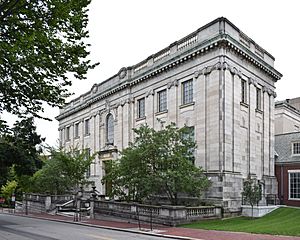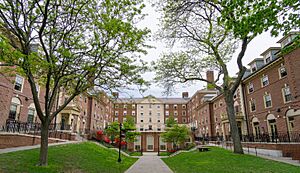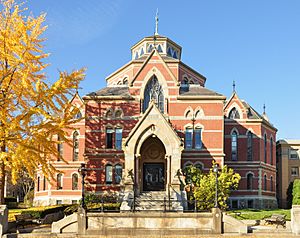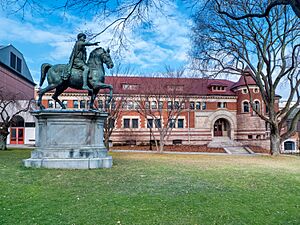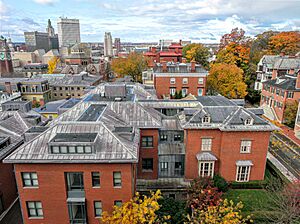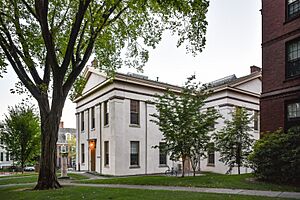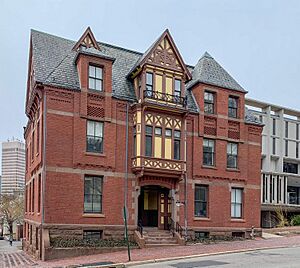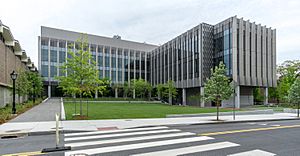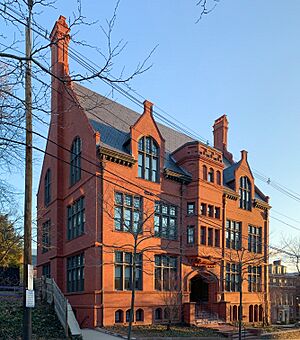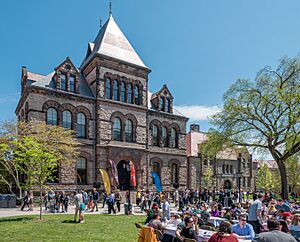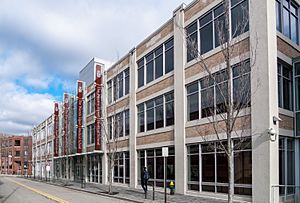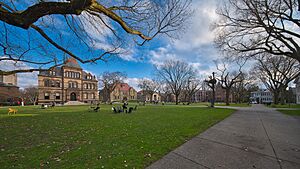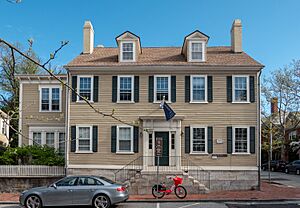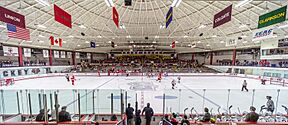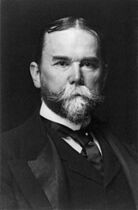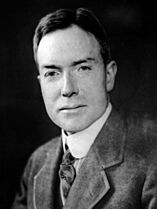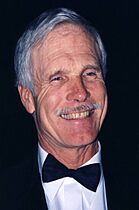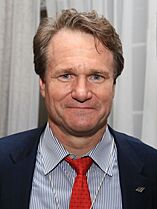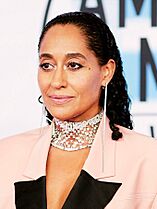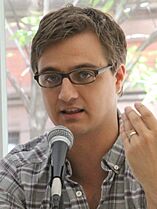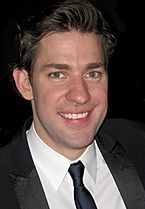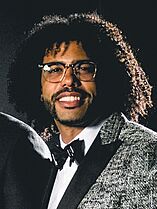Brown University facts for kids
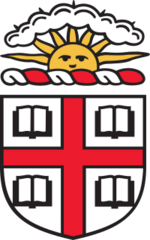
Coat of arms
|
|
| Latin: Universitas Brunensis | |
|
Former names
|
Rhode Island College (1764–1804) |
|---|---|
| Motto | In Deo Speramus (Latin) |
|
Motto in English
|
"In God We Hope" |
| Type | Private research university |
| Established | September 15, 1764 |
| Accreditation | NECHE |
|
Academic affiliations
|
|
| Endowment | $7.2 billion (2024) |
| Budget | $1.28 billion (2023) |
| Chancellor | Brian Moynihan |
| President | Christina Paxson |
| Provost | Francis J. Doyle III |
|
Academic staff
|
848 |
| Students | 10,737 |
| Undergraduates | 7,222 |
| Postgraduates | 2,920 595 medical students |
| Location |
,
,
United States
41°49′34″N 71°24′11″W / 41.82611°N 71.40306°W |
| Campus | Midsize city, 143 acres (58 ha) |
| Other campuses | |
| Newspaper | The Brown Daily Herald |
| Colors | Seal Brown, White, and Cardinal |
| Nickname | Bears |
|
Sporting affiliations
|
|
| Mascot | Bruno the Bear |
| Website | brown.edu |
Brown University is a private, top-ranked university in Providence, Rhode Island, USA. It is part of the Ivy League, a group of eight famous universities in the Northeastern United States. Brown is the seventh-oldest college in the US, started in 1764. It was one of the first colleges to welcome students of all religions.
Brown is known for having the oldest program in applied mathematics and the oldest engineering program in the Ivy League. In 1969, Brown started its "Open Curriculum." This means students can choose almost any classes they want, without many required courses. In 1971, Pembroke College, which was a women's college connected to Brown, fully joined the university.
The university has several schools, including the College (for undergraduate students), the Graduate School, a Medical School, and schools for Engineering and Public Health. Brown's main campus is on College Hill in Providence. The area around the university has many old buildings from the 17th and 18th centuries. Getting into Brown is very competitive, with only a small percentage of students accepted each year.
Many famous people have studied or taught at Brown. This includes Nobel Prize winners, Pulitzer Prize winners, and leaders in government, business, and the arts.
Contents
- Discovering Brown University's History
- Brown University's Campus
- Learning at Brown University
- The College
- Brown and RISD: A Creative Partnership
- Theatre and Playwriting
- Writing Programs
- Computer Science
- Applied Mathematics
- Archaeology and Ancient Studies
- Watson Institute for International and Public Affairs
- School of Engineering
- IE Brown Executive MBA Program
- Pembroke Center
- Graduate School
- Carney Institute for Brain Science
- Alpert Medical School
- School of Public Health
- Online Programs
- Getting into Brown University
- Rankings
- Research at Brown
- Student Life
- Athletics
- Notable People
- Brown University in Popular Culture
- See also
Discovering Brown University's History
How Brown University Started
In 1761, three people from Newport, Rhode Island, wanted to open a school. They asked the colony's government for permission. These people included Ezra Stiles, who later became president of Yale University, and William Ellery, who signed the United States Declaration of Independence.
At the same time, a group called the Philadelphia Baptist Association also wanted to create a college in Rhode Island. They wanted a college where Baptists would have a strong role, as Baptists were not well-represented in other colonial colleges like Harvard or Yale. James Manning, a Baptist minister, was chosen to lead this effort.
Manning arrived in Newport in 1763. Ezra Stiles helped write the first plan for the college. After some changes to make sure Baptists were well-represented, the plan was approved on March 3, 1764. The college was first called Rhode Island College.
The first meeting of the college's leaders happened in September 1764. James Manning became the first president in 1765. In 1766, a minister named Morgan Edwards traveled to Europe to raise money for the new school.
In 1770, the college moved from Warren to Providence. John and Moses Brown bought land on College Hill for the campus. The first building, called "The College Edifice" (now University Hall), was built. It might have looked like Nassau Hall at Princeton University, where President Manning had studied.
The Brown Family's Impact
The Brown family, especially Nicholas, John, Joseph, and Moses Brown, were very important in moving the college to Providence and helping it grow.
In 1804, Nicholas Brown Jr. gave a large gift of $5,000 to the college. Because of this generous donation, the college was renamed Brown University in his honor. Over the years, Nicholas Brown Jr. gave even more money, helping to build other important buildings like Hope College and Manning Hall.
The Brown family was involved in many businesses, including the transatlantic slave trade. However, members of the family had different views on slavery. John Brown supported slavery, while Moses Brown and Nicholas Brown Jr. were strong supporters of ending it.
In 2003, Brown University started a project to study its historical connections to slavery. In 2006, a report called "Slavery and Justice" was released. It explained how the university benefited from slavery and suggested ways to address this past. Brown has since created a Center for the Study of Slavery and Justice and built a memorial.
Brown University During the American Revolution
During the American Revolutionary War, from 1776 to 1782, Brown's University Hall was used as a barracks and hospital for American and French soldiers. General George Washington and the Comte de Rochambeau used it as they prepared for important battles.
Many people connected to Brown played a role in the American Revolution. Brown's first leader, Stephen Hopkins, signed the Declaration of Independence. James Manning, the first president, also served in the early American government.
Leaders of Brown University
Brown University has had 19 presidents since it was founded. Since 2012, Christina Hull Paxson has been the president. Before her, Ruth Simmons was president, and she was the first African American president of an Ivy League university.
The Open Curriculum
In 1966, students and professors at Brown started a project to rethink how students learned. They wanted students to be more involved in choosing their classes and to learn "how to think" instead of just memorizing facts.
This led to the "New Curriculum," approved in 1969. Key changes included:
- Students could choose many more of their own classes.
- There were no longer strict "general education" requirements.
- A new grading system was introduced, where students could get "Satisfactory" or "No Credit" instead of traditional letter grades.
While some parts of the original plan changed over time, the idea of students having a lot of freedom in their studies remains a core part of Brown's education.
"Slavery and Justice" Report
In 2003, President Ruth Simmons started a committee to look into Brown's connections to slavery in the 1700s. In 2006, the committee released its "Slavery and Justice" report.
This report showed how the university had benefited from the transatlantic slave trade. It also made suggestions for how Brown could address this history. Since then, Brown has created the Center for the Study of Slavery and Justice and built a memorial. The university also set up a fund for Providence Public Schools. This report was a big step for an American university in facing its past ties to slavery.
Brown University's Campus
Brown University owns many buildings in Providence, especially on College Hill and in the Jewelry District. The campus blends in with the city's old neighborhoods. Famous architects have designed buildings at Brown, including Philip Johnson and Rafael Viñoly.
Main Campus Area
Brown's main campus has 235 buildings and covers about 143 acres. The central part of the campus has three main green spaces: the Front Green, the Middle Green, and the Ruth J. Simmons Quadrangle. Many of the older buildings here are in the Georgian and Richardsonian Romanesque styles.
South of the main campus are more academic buildings and student dorms. To the east are science buildings and the School of Engineering. North of the main campus are arts facilities and the Pembroke Campus, which has dorms and academic buildings. Two of Brown's libraries, the John Hay Library and the John D. Rockefeller Jr. Library, are on the western edge of the central campus.
Brown's campus is right next to the Rhode Island School of Design (RISD).
Van Wickle Gates
The Van Wickle Gates were built in 1901. They are large iron gates at the western edge of campus. During special events like Convocation (when new students arrive) and Commencement (when students graduate), the main gate opens. There's a fun tradition that if students walk through the central gate a second time before graduating, they won't graduate!
John Hay Library
The John Hay Library opened in 1910. It is named after John Hay, who was a secretary to Abraham Lincoln and later a US Secretary of State. This library holds many rare books, old manuscripts, and special collections. It has unique items like a collection of military history, American poetry, and the papers of writer H. P. Lovecraft. It also has very old printed books and even three books bound in human skin (which are historical artifacts).
John Carter Brown Library

The John Carter Brown Library started in 1846. It is known worldwide for its collection of historical documents, maps, and books about the exploration and colonization of the Americas. While it's managed separately, it has been on Brown's campus since 1904. It holds one of the few remaining copies of the Bay Psalm Book, the first book printed in British North America.
Haffenreffer Museum

The Haffenreffer Museum of Anthropology is Brown's teaching museum. Its main exhibits are in Manning Hall on campus. The museum has over a million artifacts, which are used for research and education. It helps students learn about different cultures and the material world.
Annmary Brown Memorial
The Annmary Brown Memorial was built between 1903 and 1907 by Rush Hawkins as a special building for his wife, Annmary Brown. It holds art from Hawkins's collection, including paintings by famous artists. Today, it is home to Brown's programs for studying the Middle Ages and the Renaissance.
Pembroke Campus
The Women's College in Brown University, known as Pembroke College, was founded in 1891. When it merged with Brown in 1971, its campus became part of the larger Brown campus. The Pembroke campus has many brick buildings, mostly in the Georgian and Victorian styles.
East Campus, bought by Brown in 1969, added more land and buildings. This area is now mostly used for student dorms.
Thayer Street, which runs through Brown's main campus, is a popular street with shops and restaurants for students.
Brown also has athletic facilities like Brown Stadium for football, Marston Boathouse for rowing, and the Ted Turner Sailing Pavilion for sailing. The Alpert Medical School is located in Providence's historic Jewelry District, near Brown's teaching hospitals.
Learning at Brown University
The College
The College is Brown's oldest school, founded in 1764. About 7,200 undergraduate students study here. Students can choose from 81 different subjects, called "concentrations." Some popular ones include Computer Science, Economics, and Biology. Many students choose to study more than one subject. If students can't find a program that fits their interests, they can even design their own.
Many Brown graduates go on to study further, with a large number earning master's or doctoral degrees. They often pursue careers in education, medicine, business, law, and technology.
Brown and RISD: A Creative Partnership

The Rhode Island School of Design (RISD) is an art and design school right next to Brown. Since 1900, students from both schools have been able to take classes at the other institution. This creates a lively cultural scene on College Hill.
Dual Degree Program
In 2007, Brown and RISD officially started a special five-year program. This program allows students to earn two degrees: one from Brown (like a Bachelor of Arts or Science) and one from RISD (a Bachelor of Fine Arts). It's a very competitive program, combining art and design with academic studies. Students in this program often create unique projects that blend different fields, like engineering with industrial design.
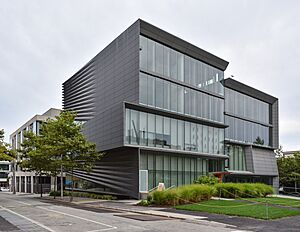
Theatre and Playwriting
Brown has highly respected programs in theatre and playwriting. Many graduates have won major awards, including the Pulitzer Prize for Drama. Students can study theatre history, acting, directing, dance, and playwriting. There are also graduate programs for acting and directing that work with a local theatre company.
Writing Programs
Brown offers many ways for students to develop their writing skills, including fiction, poetry, screenwriting, and non-fiction. The faculty includes many well-known authors. Brown alumni have won numerous national writing awards, such as the Pulitzer Prize for fiction, drama, biography, and journalism.
Computer Science

Brown started offering computer science classes in 1956. In 1960, it opened its first building just for computers. The first undergraduate degrees in Computer Science were given in 1974. Brown's computer science department became official in 1979.
In the 1960s, professors and students at Brown helped create early versions of what we now call hypertext, which is how links work on the internet. Many Brown computer science alumni have become leaders in the tech world, working at companies like Apple and Intel, or starting their own successful companies like Figma and OpenSea.
The number of students studying computer science at Brown has grown a lot in recent years, making it one of the most popular subjects.
Applied Mathematics
Brown's program in applied mathematics started in 1941, making it the oldest in the United States. This program is highly regarded nationally. Many top researchers in this field have been connected to Brown.
Archaeology and Ancient Studies
The Joukowsky Institute for Archaeology and the Ancient World, started in 2004, is Brown's center for studying ancient cultures. Researchers here explore ancient sites in places like Jordan, Egypt, Turkey, and Italy. They study the art, architecture, and history of these ancient civilizations.
Brown also has a unique Department of Egyptology and Assyriology, which studies ancient Egypt and Mesopotamia. It's one of only a few such departments in the US.
Watson Institute for International and Public Affairs
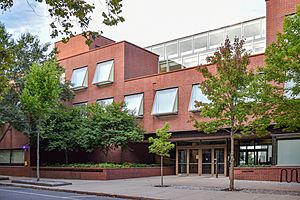
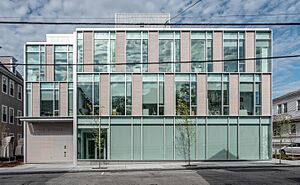
The Watson Institute for International and Public Affairs is Brown's center for studying global issues and public policy. It's a leading institute in its field. Many important international figures, including former presidents and prime ministers, have been part of the institute's faculty.
The institute focuses on topics like global development, security, and how governments work. It hosts several undergraduate and graduate programs, including International Relations and Public Policy. One of its well-known projects is the "Costs of War Project," which studies the human and economic costs of recent wars.
School of Engineering
Brown's engineering program, started in 1847, is the oldest in the Ivy League. In 2010, it became a full School of Engineering. Brown's engineering program is known for being very interdisciplinary, meaning engineers work closely with experts from other fields like biology, medicine, and computer science.
Students at Brown's School of Engineering have even launched their own small satellites into space!
IE Brown Executive MBA Program
Since 2009, Brown has partnered with IE Business School in Madrid, Spain, to offer an Executive MBA program. This program helps working professionals earn a master's degree in business. Classes are held in Providence, Madrid, Cape Town, and online.
Pembroke Center
The Pembroke Center for Teaching and Research on Women was founded at Brown in 1981. It is a research center that focuses on gender studies. The center supports programs for students and researchers, and it manages important collections related to women's history.
Graduate School
Brown started offering graduate courses in the 1870s and awarded its first advanced degrees in 1888. The Graduate School was fully established in 1927. It offers many master's and doctoral programs to about 2,600 students. Getting into the Graduate School is very competitive.
Carney Institute for Brain Science
The Carney Institute for Brain Science is Brown's research center for neuroscience. It focuses on understanding the brain, including how brain-computer interfaces work and how to develop treatments for brain diseases. The institute received a very large gift in 2018, making it one of the best-funded neuroscience programs in the country.
Alpert Medical School
Brown's Alpert Medical School was established in 1811, making it the fourth oldest medical school in the Ivy League. In 2007, it was renamed the Warren Alpert Medical School after a generous donation.
The medical school is known for its special eight-year program called the Program in Liberal Medical Education (PLME). This program allows students to enter medical school directly after high school. It is one of the most selective medical programs in the US.
School of Public Health

Brown's School of Public Health became an independent school in 2013. It offers degrees at all levels, from undergraduate to doctoral, focusing on public health issues.
Online Programs
Brown University also offers online master's degrees for working professionals in fields like Healthcare Leadership and Cyber Security. The university has also created online courses called MOOCs (Massive Open Online Courses) on platforms like edX, covering various subjects.
Getting into Brown University
Undergraduate Admissions
Getting into Brown University as an undergraduate student is very difficult. For the class entering in 2026, Brown received over 50,000 applications, and only about 5% of applicants were accepted.
Brown has a "need-blind" admissions policy for US students. This means that when they decide whether to admit a student, they don't consider whether the student needs financial help. Starting with the class entering in 2029, this policy will also apply to international students. Brown also announced that it would no longer include loans in its financial aid packages for undergraduate students, making it easier for students to afford their education.
Graduate Admissions
Admission to Brown's Graduate School is also very competitive. For example, in 2021, the Master of Public Health program received nearly 1,000 applications for about 90 spots. The Alpert Medical School is also highly selective, accepting only a small percentage of applicants.
Rankings
Brown University is a highly ranked university. It is accredited by the New England Commission of Higher Education. In recent years, it has been ranked among the top national universities by publications like U.S. News & World Report and Forbes.
Brown is also known for being a very entrepreneurial university, meaning many of its alumni start their own businesses. The university has also produced the most Fulbright recipients in the nation several times, and many Rhodes Scholars.
Research at Brown
Brown is a major research university, known for its "Very High Research Activity." In 2017, Brown spent over $212 million on research. The School of Public Health, for example, receives a lot of funding for its research projects.
Student Life
Campus Safety
Brown University works to ensure the safety of its students. Like all universities, it reports incidents to the public.
Spring Weekend
Spring Weekend is an annual music festival for students, held every spring since 1950. Many famous musicians have performed at this festival over the years, including Bob Dylan, Janis Joplin, and Kendrick Lamar. Students organize the event through the Brown Concert Agency.
Residential and Greek Life
About 12% of Brown students are part of Greek Life organizations. There are 13 recognized Greek groups on campus, and they are all located in Wriston Quadrangle.
Societies and Clubs
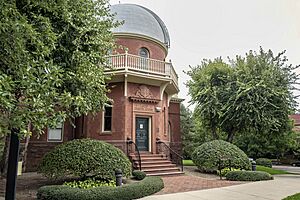
In the early days of Brown, students formed societies for debating and learning. These groups often had their own libraries. Later, fraternities became more popular.
The Cammarian Club was once a student group that acted as the student government. Today, Brown has a formal student government.
Student Organizations
Brown has over 300 registered student organizations, covering many different interests. Students can join groups like:
- The Brown Daily Herald (the student newspaper)
- The Brown Debating Union
- Music groups like The Brown Derbies and the Brown University Orchestra
- The Ivy Film Festival
- Radio stations like BSR and WBRU
LGBTQ+ Community
Brown has a strong and visible LGBTQ+ community. A recent poll showed that a significant percentage of Brown students identify as LGBTQ+. The university has an LGBTQ Center that provides support and resources for students.
Resource Centers
Brown has several resource centers that offer support and safe spaces for students.
- The Brown Center for Students of Color (BCSC) helps students of color. It offers programs and encourages discussions about social justice.
- The Sarah Doyle Women's Center provides a space to explore issues related to gender. It emphasizes intersectionality, looking at how gender connects with other parts of a person's identity.
- Other centers include the LGBTQ Center, the Undocumented, First-Generation College and Low-Income Student (U-FLi) Center, and the Curricular Resource Center.
Student Activism
1968 Black Student Walkout
In December 1968, Black students at Brown and Pembroke College organized a walkout. They felt the colleges were not doing enough to support Black students. They demanded that more Black students be admitted. This led to a big increase in Black student enrollment the next year.
Divestment from South Africa
In the mid-1980s, students at Brown pushed the university to stop investing in companies that did business in South Africa, due to the country's apartheid system. Students held protests and hunger strikes to achieve this.
Protests for Social Justice
Brown students have continued to be active in social justice issues. In 2013, students protested a speech by a police commissioner. More recently, in late 2023 and early 2024, students held protests and sit-ins related to the conflict in Gaza, calling for a ceasefire and for the university to stop investing in certain companies.
Athletics
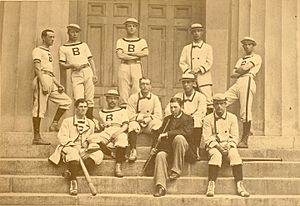
Brown is part of the Ivy League athletic conference and competes in Division I sports. The Brown Bears have one of the largest university sports programs in the US, with 32 different varsity teams.
Brown's women's rowing team has won several national titles. The men's rowing team also consistently ranks among the top in the nation. Brown's men's soccer team has won many Ivy League titles. The football team has also won Ivy League championships.
Brown's women's gymnastics team has won Ivy League tournaments. The sailing teams, both women's and coed, have won national championships.
Brown has a long history in college sports. The first intercollegiate ice hockey game in America was played between Brown and Harvard in 1898.
Brown also has strong club sports, like the men's ultimate frisbee team, Brownian Motion, which has won four national championships.
Notable People
Alumni
Many Brown alumni have become famous in various fields:
- Politics and Government: John Hay (US Secretary of State), Charles Evans Hughes (Chief Justice of the United States), Janet Yellen (US Secretary of the Treasury), Maggie Hassan (US Senator), Bobby Jindal (Governor of Louisiana), Andrew Yang (presidential candidate).
- Business and Finance: John D. Rockefeller Jr. (philanthropist), Ted Turner (founder of CNN), Brian Moynihan (CEO of Bank of America), John Sculley (former CEO of Apple Inc.), Dara Khosrowshahi (CEO of Uber).
- Arts and Media: Actors like Emma Watson, John Krasinski, Daveed Diggs, Julie Bowen, and Tracee Ellis Ross. Writers like Jeffrey Eugenides and Marilynne Robinson. Journalists like James Risen and Chris Hayes.
- Education: Horace Mann (father of American public school education), John Hope (first African-American president of Morehouse College).
- Computer Science: John H. Crawford (architect of Intel microprocessors), Andy Hertzfeld (Macintosh developer), Dylan Field (founder of Figma).
- Other Notable Alumni: Thomas O. Paine (NASA head during early Apollo missions), Chris Berman (sportscaster), Joe Paterno (Penn State football coach), and several members of royal families.
Brown alumni have also won Nobel Prizes, including Craig Mello (Physiology or Medicine) and Douglas Diamond (Economic Sciences).
- '''Notable Brown University alumni include:'''
-
Horace Mann, class of 1819, known as the father of American public education
-
John Hay, class of 1858, private secretary to Abraham Lincoln and later US Secretary of State
-
Charles Evans Hughes, class of 1881, who became Chief Justice of the United States
-
John D. Rockefeller Jr., class of 1897, a famous philanthropist
-
Ted Turner, class of 1960, who founded CNN
-
Janet Yellen, class of 1967, the first woman to lead the Federal Reserve and US Secretary of the Treasury
-
Maggie Hassan, class of 1980, a US Senator from New Hampshire
-
John F. Kennedy Jr., class of 1983, a lawyer and magazine publisher
-
Laura Linney, class of 1986, an actress who has won many awards
-
Julie Bowen, class of 1991, an actress known for her TV roles
-
Tracee Ellis Ross, class of 1994, an actress and comedian
-
John Krasinski, class of 2001, an actor, director, and producer
-
Daveed Diggs, class of 2004, an actor and rapper who won a Grammy and Tony Award
-
Emma Watson, class of 2014, a well-known actress and model
Faculty
Brown's faculty (professors and researchers) include seven Nobel Laureates, such as Leon Cooper (Physics) and J. Michael Kosterlitz (Physics). Other notable faculty members include famous biologists, computer scientists, economists, historians, and writers. Political figures like former Italian Prime Minister Romano Prodi and former Brazilian President Fernando Cardoso have also taught at Brown.
Brown University in Popular Culture
Brown University is sometimes mentioned in movies and TV shows. For example, the character Brian Griffin from Family Guy is a Brown alumnus. In The O.C., characters Seth Cohen and Summer Roberts apply to Brown.
See also
 In Spanish: Universidad Brown para niños
In Spanish: Universidad Brown para niños
- List of Brown University statues
- Brown University Alma Mater
- Josiah S. Carberry


